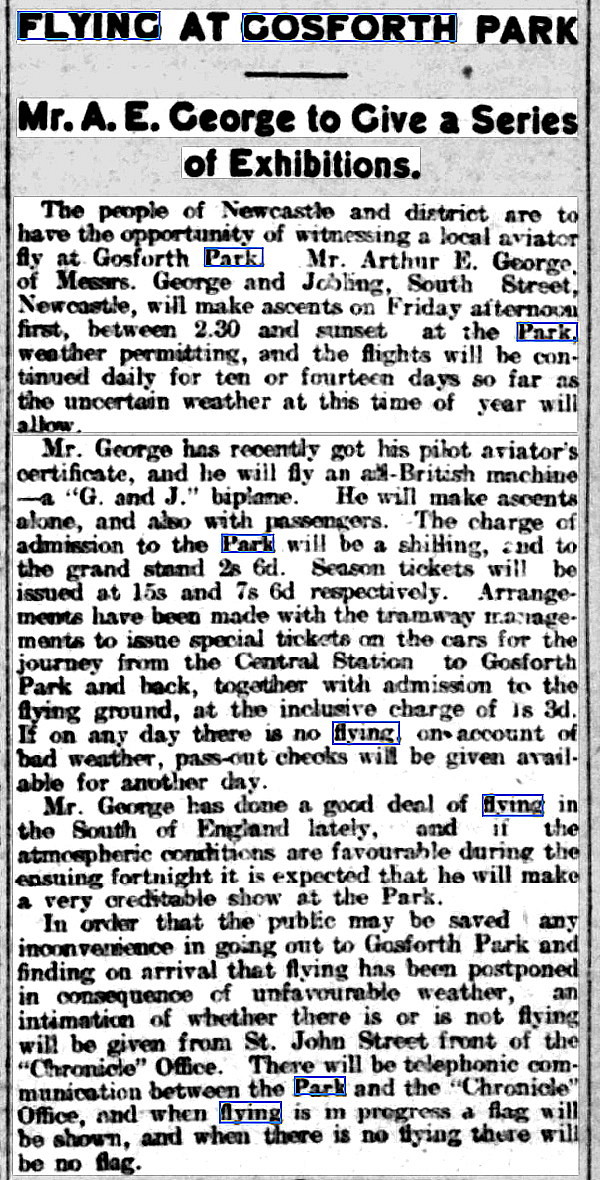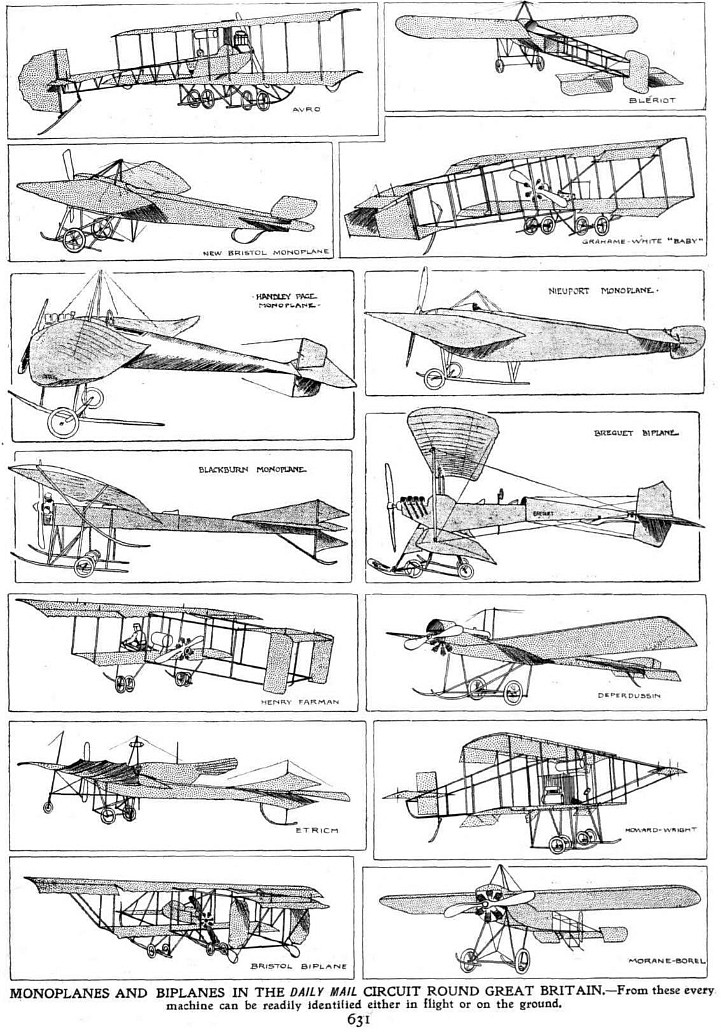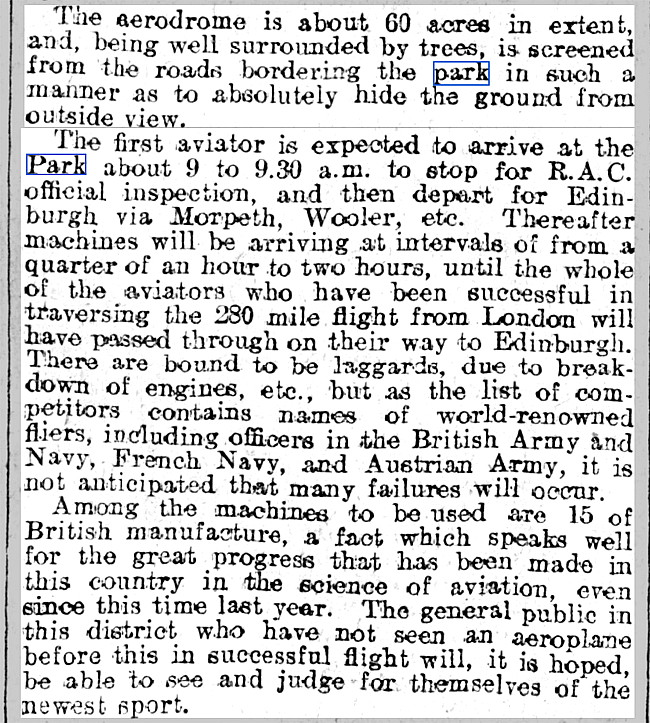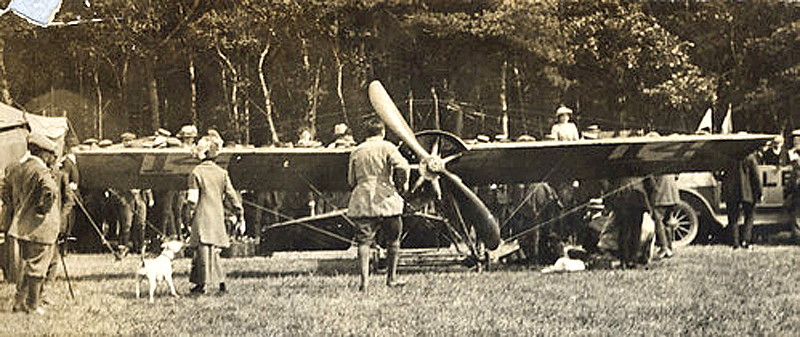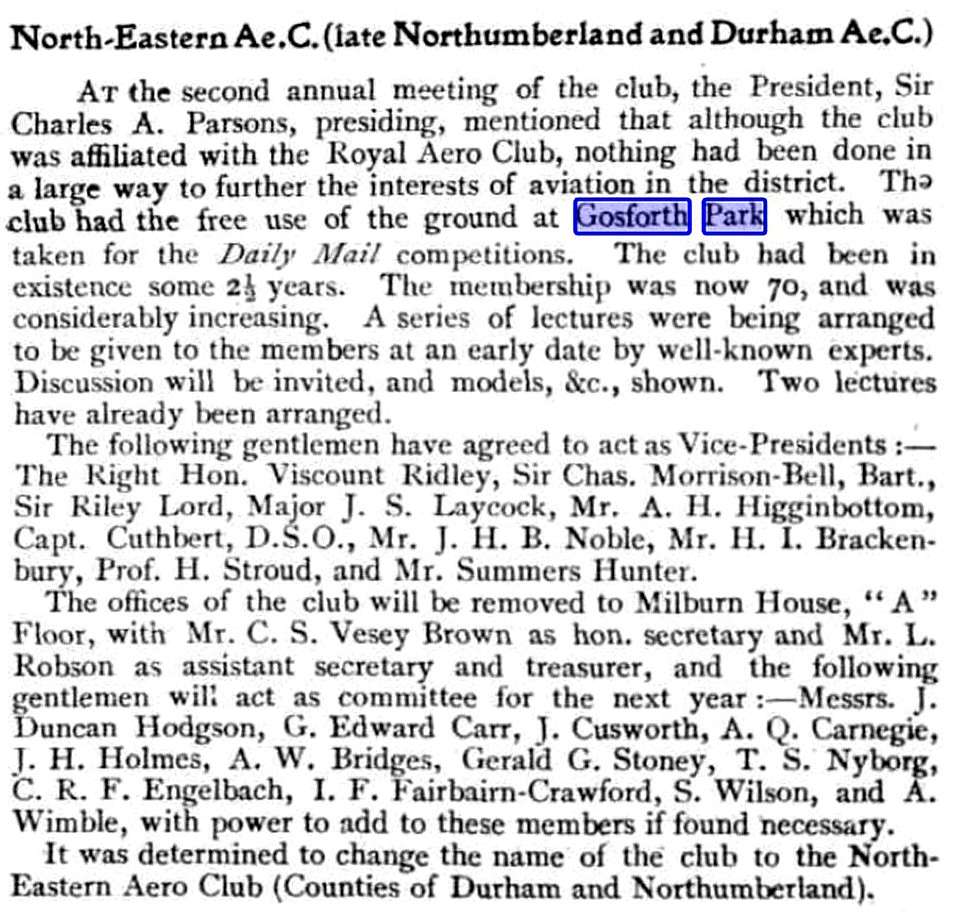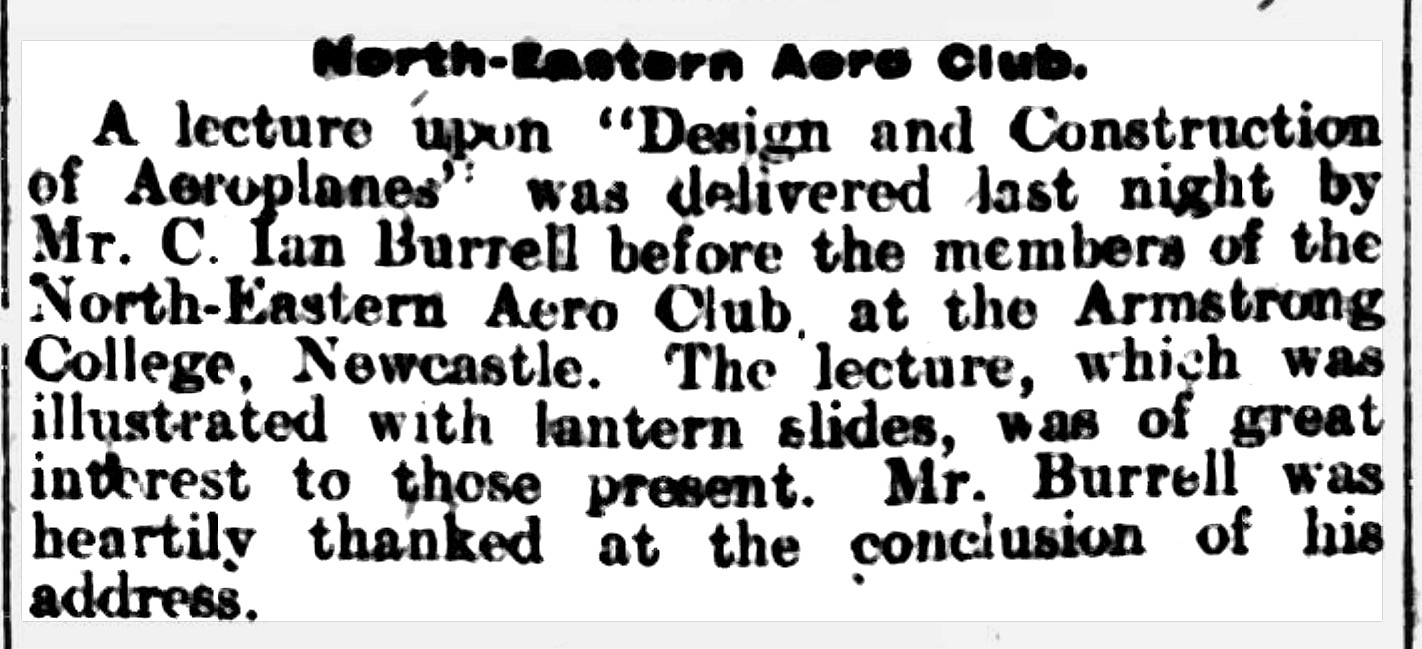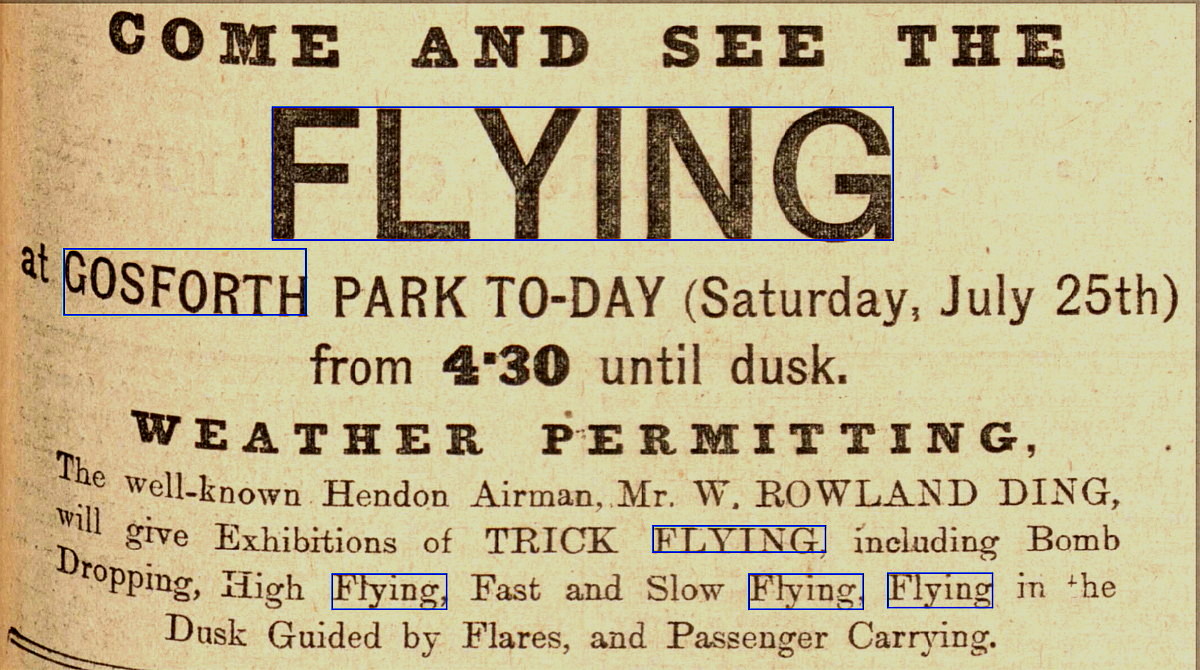Gosforth flying sites
GOSFORTH see also GOSFORTH PARK HOTEL
GOSFORTH: Temporary flying field?
Note: This site does seem to be TOWN MOOR? See seperate entry. But was it? If anybody can help to sort this out, such advice will be most welcome.
NOTES: Ron Smith in his book British Built Aircraft Vol.5 mentions that the George & Jobling 1910 biplane made several successful flights at GOSFORTH and was exhibited at the 1910 Olympia Show in London. My question is of course, where exactly did this aeroplane fly from? Possibly TOWN MOOR? One major problem in researching this 'Guide' is that I have to rely mainly on written accounts which are invariably vague on providing locations, and, no maps.
It does seem to indicate that some confusion appears to exist between GOSFORTH PARK and TOWN MOOR - which is perhaps odd? TOWN MOOR being roughly equi-distant between GOSFORTH PARK and Newcastle city centre.
GOSFORTH PARK: Racecourse and temporary aerodrome, later Airship Moorings
Venue for several aviation events from 1910 until 1914
Location: About 4nm N of Newcastle city centre
Military user: RNAS (Royal Naval Air Service) For airship moorings in WW1 (Until 1917)
A MICHAEL T HOLDER GALLERY
We have Mike Holder, a great friend of this 'Guide', to thank for delving into the records and discovering the following items, plus a map and pictures.
1910
Note: The second item, a newspaper notice, was published in the Jarrow Express on the 29th July 1910. The third item, a picture, was published in the Newcastle Daily Chronicle on the 8th August 1910 and shows Claude Grahame-White flying here on the 6th August. The fourth item was published in the Newcastle Evening Chronicle on the 4th October 1910 and tells us that Mr Arthur E George intended to make several flights over several days, commencing on the 7th October.
1911
Without any doubt GOSFORTH PARK came into the spotlight, gaining national if not global recognition, when it was nominated as a staging post for the Daily Mail Circuit of Great Britain Air Race. This was, at that time, a quite astonishing project - nothing like it had ever been staged in the UK.
The list of pilots competing and illustrations of the aircraft types was published in Flight magazine on the 22nd July 1911. The picture of Mr Valentine with his Deperdussin being wheeled out, is courtesy of Newcastle Libraries.
Note: Picture One is captioned as "Jules Vedrines preparing his Morane-Borel monoplane for take-off".
I think this is incorrect, it clearly shows it had No.1 on its wings, therefore making it the Blériot being flown by André Beaumont. Picture Two is of James Valentine, the only one not wearing a hat.
Note: The second and third pictures are courtesy of Newcastle Libraries.
The first two part article was published in the Durham Chronicle on the 21st July 1911. The next newspaper article was published in the Daily Mirror on the 25th July. The last newspaper article was published in the Daily News (London) also on the 25th July 1911.
Note: All three pictures are courtesy of Newcastle Libraries. Picture Three shows M Tabuteau's Bristol biplane (No.21) with Ronald C Kemp's Avro biplane (No.6) behind.
Picture Four shows Jules Vedrines (on the left) and James Valentine seen at HENDON at the start of the race. Picture Five was of James Valentine as he approached his Deperdussin monoplane here.
1912
Without any doubt the new fangled aviation era had now arrived in the north-east of England.
The first article was published in the Yorkshire Post and Leeds Intelligencer on the 8th January 1912. The article in Flight magazine was published on the 20th January. The third item above was published in the Newcastle Daily Chronicle on the 15th February. The fourth item, a short article, was published in Flight magazine on the 10th August 1912.
1913
It certainly seems rather odd, February normally being in the UK the height of winter, but, at least two major events were taking place here. This said of course, as has happened in this month in 2023, when a large settled high pressure weather system comes around, flying conditions can rarely be better although early morning fog is of course always likely to occur. At more or less the same time as B C Hucks was conducting the first 'air cargo' flights in this region, the Royal Flying Corps had decided to fly a squadron of their aircraft to Montrose in Scotland, to form a new 'air base' there.
The newspaper notice above was published in the Newcastle Evening Chronicle on the 21st February 1913. The newspaper article, concerning the RFC fliers arriving here whilst en route to MONTROSE, was published in The Scotsman on the 24th February 1913. The last article is of interest, because, although relating to B C Hucks first parcel flights from here in February 1913, this account was published on the 3rd September 1925!
1914
Note: The excerpt is from Handley Page Aircraft since 1907 by C H Barnes. In this case when Roland Ding was flying a Handley Page Type 6100.
The notice in the newspaper was published in the Newcastle Journal on the 25th July 1914. The article about Roland Ding 'getting lost' was published in the Dundee Evening Telegraph on the 29th July 1914.
AND FINALLY
The excerpt is from British Airships of WW1 by C F S Mowthorpe, telling us that use of GOSFORTH PARK by airships closed on the 1st October 1917. The local area view is from my Google Earth © derived database.
GOSFORTH: Private company flying field also later military aerodrome
(Also known as NEWCASTLE, DUKE’S MOOR and TOWN MOOR)
Operated by: Armstrong-Whitworth (Aircraft Department) and Angus Sanderson & Co Ltd?
Military users: RNAS (Home Defence Station) 1914 to 1915
RFC Aircraft Acceptance Park 1917 to 1919
Location: About 2.5nm N of Newcastle-upon-Tyne city centre
Period of operation: 1913 to 1921
Site area: WW1: 80 acres 689 x 689
NOTES: It appears that this airfield certainly closed when Armstrong-Whitworth moved their aircraft factory in 1921 to WHITLEY ABBEY in Coventry. However, it also appears that Armstrong-Whitworth established a flying site or ‘company aerodrome’ at TOWN MOOR in 1915. Obviously this history needs a bit of sorting?
SOMETHING TO CONSIDER?
I now believe that the Armstrong-Whitworth factory did not have an associated airfield, completed aircraft being shipped to SELBY before TOWN MOOR came into being. The WW1 RNAS site being a separate entity?
P Scott
This comment was written on: 2019-04-25 17:06:34I believe the Gosforth aerodrome was on the town moor. I saw this on a tv programme, a house through time. Currently showing on BBC 2. It showed a map which clearly showed the aerodrome as being on the town moor.
Ashley Liddle
This comment was written on: 2019-05-01 00:05:40I know that gosforth park was an army base as my grandad was based there. It was actually on the gosforth park area , near sandy lane
Martin Webster
This comment was written on: 2019-07-02 09:17:21Hi. After watching the same House through Time program I was looking for Gosforth aerodrome too. I believe it was located on what is now the Town Moor. However I have a correction for you. The factory in Coventry was in the district of Whitley - which did have an abbey - not to be confused with Whitby which still does! There was also a factory at the village of Baginton next to Coventry airport is still located.
We'd love to hear from you, so please scroll down to leave a comment!
Leave a comment ...
Copyright (c) UK Airfield Guide

















